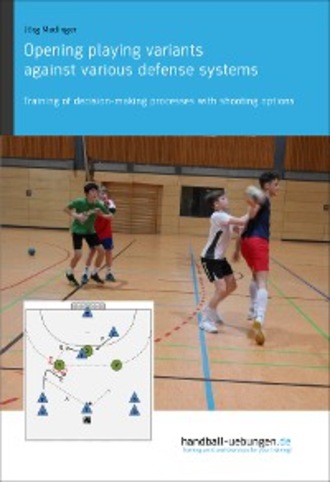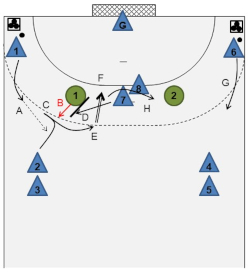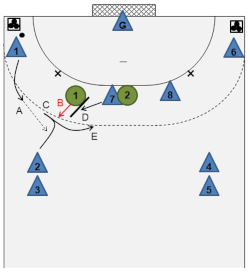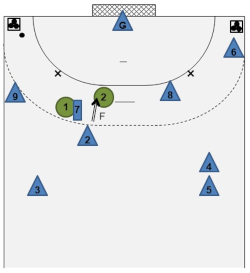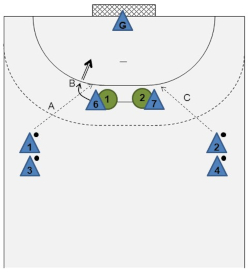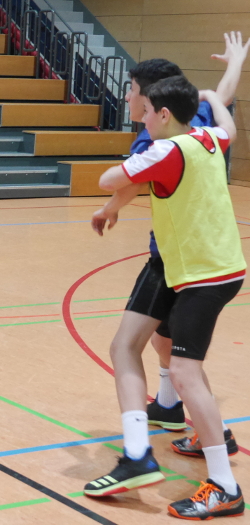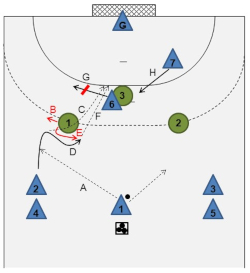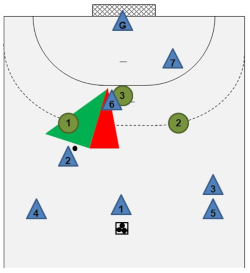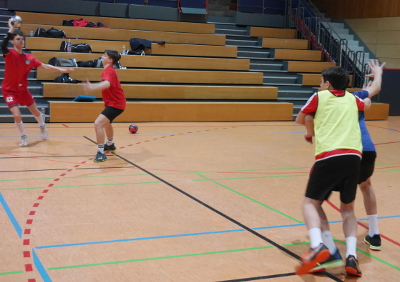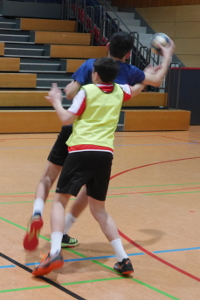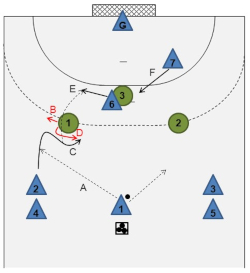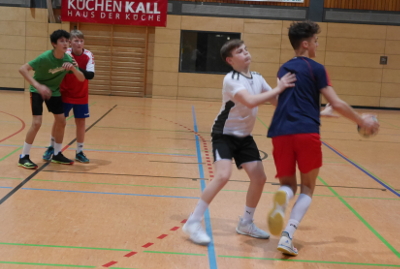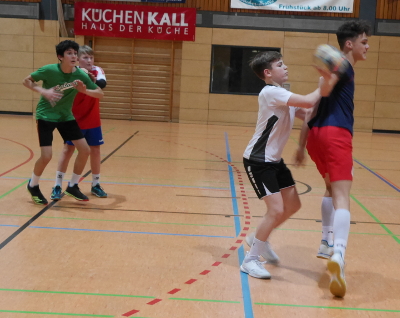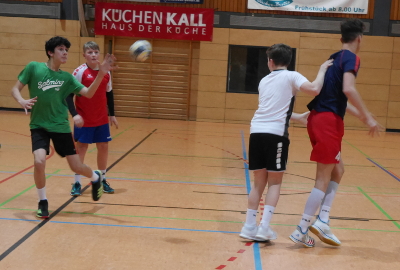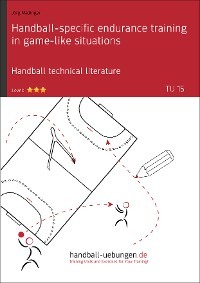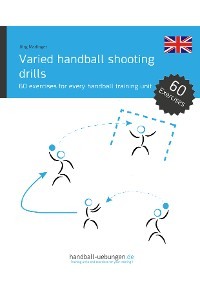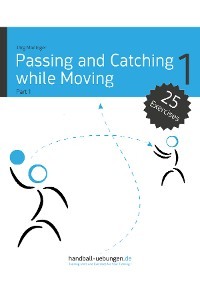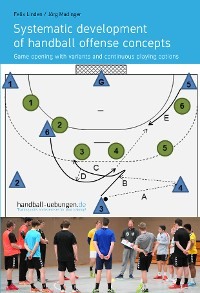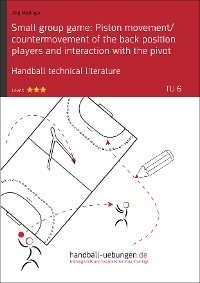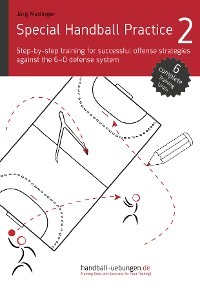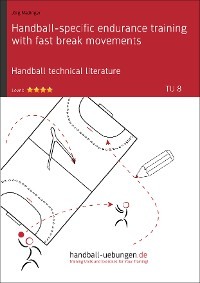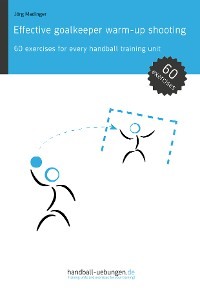Course:
-
starts the piston movement on the wing position and passes the ball into the running path of
(A).
-
steps forward towards the piston movement path of
(B).
-
makes an extensive body feint to the left, in front of
(C).
-
starts at 7-meter level, sidesteps to
, and places a screening on the inner side (D).
-
takes on the screening of
, next to
, dynamically moves to the inner side (E), and eventually makes a free jump shot at the goal (F).
- A bit delayed, the players start the same sequence on the other side, with
(G).
-
moves back again and then places the screening next to
(H).
- And so on.
-
and
switch positions after the action.
should time the screening in such a way that he stands next to
just before
changes the direction and moves to the inner side (E).
A2.2 Implementation: Playing the Russian Screen 2-on-2
Basic course:
-
and play defense together and try to defend against and . -
should not interfere but wait until it is his turn during the subsequent action on the other side.
(Figure 1)
Course (figure 1):
-
starts the piston movement on the wing position and passes the ball into the running path of (A). -
initially stands close to . -
actively steps forward towards the piston movement path of (B). -
makes an extensive body feint to the left, in front of (C). -
leaves the screening next to , moves forward, and places a screening next to , on the inner side (D). -
takes on the screening of , next to , and dynamically moves to the inner side (E).
(Figure 2)
- If
remains defensive, makes a jump shot at the goal (F) (= option 1). - If
actively makes a step forward, towards , leaves the screening next to , moves backward, receives a pass from (G), and eventually shoots at the goal (H) (= option 2). Repeat on the left and right side alternately; the defense players should change sides. should initially place a screen next to vigorously, before placing the screening next to (D).
A3: Direct passes to the pivot to overcome offensive defense systems
Recommended for overcoming these defense systems: 3-2-1, 3-3
Requirement:
Description:
With this series of exercises, the players develop different passing options to the pivot when playing against offensive defense systems.
Factors of success for the pivot:
- Screenings to gain positional advantage before receiving the ball.
- Proper catching under pressure – also with one hand only.
- Turning around and shooting under pressure.
Factors of success for the back position player:
- Different passing variants.
- Identifying situations in which the pivot is in a good position for receiving a pass, also while moving.
- Decision-making: Breakthrough, parallel pass or pass to the pivot.
Implementation:
Passes to the pivot following different initial actions are a factor of success against any defense system. The players initially play against offensive defense systems; usually, there are large gaps which can be used by the pivot, and passing the ball to the pivot is possible very frequently.
A3.1 Preparatory exercise 1: Passing to the pivot
Setting:
- The players each have a ball and stand on both back positions. They should stand broadly (close to the side line).
- One pivot and one defense player each stand on either side of the 7-meter line.
Basic position of the pivot:
-
stands in basic position, placing a screen next to , and stretching the hand upward that is further away from the defense player, to catch a pass (figure 2). -
should keep the defense player behind by using his body and a proper leg posture. -
must not use his left arm for screening off (in the example), but rather hold it in front of his body.
(Figure 1)
Course:
-
passes the ball to in direction of the latter’s hand stretched upward. -
should catch the ball with one hand (ideally) (A). - As soon as he has caught the ball,
turns around and shoots at the goal (B). - Afterwards, the players start the sequence over on the other side, with
and (C).
(Figure 2)
Instructions for the two defense players:
- At the beginning of the exercise, the defense player should allow the catching, turning and shooting moves.
- In the next step, the defense player should increase the pressure right before the pivot receives the pass and try to leave the screen.
- As soon as the pivot has received the ball, the defense player should vigorously try to prevent him from shooting at the goal.
The pivots should place the screening in such a way that the defense player always stands behind them.
A3.2 Preparatory exercise 2: Finding the right timing for a pass
Setting:
- The two foremost defense players (
and ) initially stand at the 9-meter line. - The pivot and the respective defense player (
and ) start at the 7-meter line.
(Figure 1)
Course:
-
passes the ball into the running path of (A). -
should move a bit to the left, towards , so that must sidestep towards the outer side in order to adjust his position (B).
(Figure 2)
→
places a screen next to (see previous exercise – figure 2). - If the passing path to the inner side, i.e. to
, is unobstructed, should pass the ball to directly (C). - If the passing path to the inner side is obstructed,
should try to break through to the inner side 1-on-1 (D). →
should take care that his throwing hand is never blocked so that he can play a pass anytime. -
should try to prevent a breakthrough to the inner side (E). - As soon as the passing path to
has become free during the 1-on-1 action, the pass should be played (F) (figure 3).
(Figure 3)
The pass should ideally be played in direction of the hand stretched upward by , so that he ideally can catch it with one hand (figure 4).
(Figure 4)
-
catches the ball, turns around immediately, and shoots at the goal (not in the figure). - Afterwards, the players repeat the course on the other side.
may take a short break; places the screen next to (H). should keep his screening position in any case and must not leave his position to the left (G).
The ball may be passed to only if a diagonal pass is possible (green zone). If and stand in a line (red zone), might block the pass with his hand or catch the ball. A pass within the red zone is only possible if there is a significant distance between and .
A3.3 Preparatory exercise 3: Playing tricky passes
Setting:
- The two foremost defense players (
and ) initially stand at the 9-meter line. - The pivot and the respective defense player (
and ) start at the 7-meter line.
(Figure 1)
Course:
-
passes the ball into the running path of (A). -
should move a bit to the left, towards , so that must sidestep towards the outer side in order to adjust his position (B). -
tries to break through to the inner side (C) (figure 2). →
should take care that his throwing hand is never blocked so that he can play a pass anytime. -
should try to prevent a breakthrough to the inner side by all means (D). -
plays a sideward pass to behind his head (E) (figure 3).
(Figure 2)
(Figure 3)
should take care not to collide with the defense player (offensive foul). When passing the ball, the player should only rotate his shoulder and arm. -
leaves his screening position next to , runs to the left, picks up the ball (figure 4), and shoots at the goal (E).
(Figure 4)
should keep his screening position for a long time nevertheless and must not start too early, as otherwise the ball will be passed towards his back. 